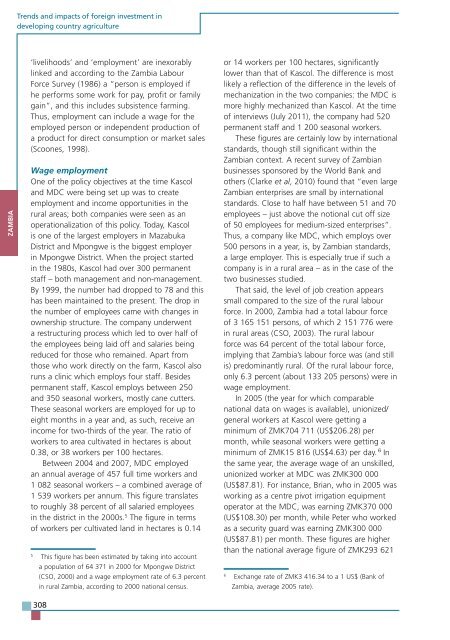TRENDS AND IMPACTS OF FOREIGN INVESTMENT IN DEVELOPING COUNTRY AGRICULTURE
TRENDS AND IMPACTS OF FOREIGN INVESTMENT IN DEVELOPING COUNTRY AGRICULTURE
TRENDS AND IMPACTS OF FOREIGN INVESTMENT IN DEVELOPING COUNTRY AGRICULTURE
You also want an ePaper? Increase the reach of your titles
YUMPU automatically turns print PDFs into web optimized ePapers that Google loves.
ZAMBIA<br />
Trends and impacts of foreign investment in<br />
developing country agriculture<br />
‘livelihoods’ and ‘employment’ are inexorably<br />
linked and according to the Zambia Labour<br />
Force Survey (1986) a “person is employed if<br />
he performs some work for pay, profit or family<br />
gain”, and this includes subsistence farming.<br />
Thus, employment can include a wage for the<br />
employed person or independent production of<br />
a product for direct consumption or market sales<br />
(Scoones, 1998).<br />
Wage employment<br />
One of the policy objectives at the time Kascol<br />
and MDC were being set up was to create<br />
employment and income opportunities in the<br />
rural areas; both companies were seen as an<br />
operationalization of this policy. Today, Kascol<br />
is one of the largest employers in Mazabuka<br />
District and Mpongwe is the biggest employer<br />
in Mpongwe District. When the project started<br />
in the 1980s, Kascol had over 300 permanent<br />
staff – both management and non-management.<br />
By 1999, the number had dropped to 78 and this<br />
has been maintained to the present. The drop in<br />
the number of employees came with changes in<br />
ownership structure. The company underwent<br />
a restructuring process which led to over half of<br />
the employees being laid off and salaries being<br />
reduced for those who remained. Apart from<br />
those who work directly on the farm, Kascol also<br />
runs a clinic which employs four staff. Besides<br />
permanent staff, Kascol employs between 250<br />
and 350 seasonal workers, mostly cane cutters.<br />
These seasonal workers are employed for up to<br />
eight months in a year and, as such, receive an<br />
income for two-thirds of the year. The ratio of<br />
workers to area cultivated in hectares is about<br />
0.38, or 38 workers per 100 hectares.<br />
Between 2004 and 2007, MDC employed<br />
an annual average of 457 full time workers and<br />
1 082 seasonal workers – a combined average of<br />
1 539 workers per annum. This figure translates<br />
to roughly 38 percent of all salaried employees<br />
in the district in the 2000s. 5 The figure in terms<br />
of workers per cultivated land in hectares is 0.14<br />
5 This figure has been estimated by taking into account<br />
a population of 64 371 in 2000 for Mpongwe District<br />
(CSO, 2000) and a wage employment rate of 6.3 percent<br />
in rural Zambia, according to 2000 national census.<br />
308<br />
or 14 workers per 100 hectares, significantly<br />
lower than that of Kascol. The difference is most<br />
likely a reflection of the difference in the levels of<br />
mechanization in the two companies: the MDC is<br />
more highly mechanized than Kascol. At the time<br />
of interviews (July 2011), the company had 520<br />
permanent staff and 1 200 seasonal workers.<br />
These figures are certainly low by international<br />
standards, though still significant within the<br />
Zambian context. A recent survey of Zambian<br />
businesses sponsored by the World Bank and<br />
others (Clarke et al, 2010) found that “even large<br />
Zambian enterprises are small by international<br />
standards. Close to half have between 51 and 70<br />
employees – just above the notional cut off size<br />
of 50 employees for medium-sized enterprises”.<br />
Thus, a company like MDC, which employs over<br />
500 persons in a year, is, by Zambian standards,<br />
a large employer. This is especially true if such a<br />
company is in a rural area – as in the case of the<br />
two businesses studied.<br />
That said, the level of job creation appears<br />
small compared to the size of the rural labour<br />
force. In 2000, Zambia had a total labour force<br />
of 3 165 151 persons, of which 2 151 776 were<br />
in rural areas (CSO, 2003). The rural labour<br />
force was 64 percent of the total labour force,<br />
implying that Zambia’s labour force was (and still<br />
is) predominantly rural. Of the rural labour force,<br />
only 6.3 percent (about 133 205 persons) were in<br />
wage employment.<br />
In 2005 (the year for which comparable<br />
national data on wages is available), unionized/<br />
general workers at Kascol were getting a<br />
minimum of ZMK704 711 (US$206.28) per<br />
month, while seasonal workers were getting a<br />
minimum of ZMK15 816 (US$4.63) per day. 6 In<br />
the same year, the average wage of an unskilled,<br />
unionized worker at MDC was ZMK300 000<br />
(US$87.81). For instance, Brian, who in 2005 was<br />
working as a centre pivot irrigation equipment<br />
operator at the MDC, was earning ZMK370 000<br />
(US$108.30) per month, while Peter who worked<br />
as a security guard was earning ZMK300 000<br />
(US$87.81) per month. These figures are higher<br />
than the national average figure of ZMK293 621<br />
6 Exchange rate of ZMK3 416.34 to a 1 US$ (Bank of<br />
Zambia, average 2005 rate).


